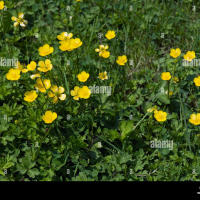Creeping buttercup
Ranunculus repens
Introduction: Ranunculus repens, commonly known as Creeping Buttercup, is a low-growing perennial plant belonging to the Ranunculaceae family. Native to Europe and Asia, it has become naturalized in various parts of the world. Creeping Buttercup is known for its characteristic yellow flowers and creeping habit, making it both an ornamental and a problematic weed in certain contexts.
Identification:
1. Morphology:
- Height: Creeping Buttercup typically grows close to the ground but can reach up to 50 centimeters in height.
- Leaves: Glossy, deeply lobed, and three-lobed or three-parted leaves.
- Stems: Creeping stems (stolons) that root at nodes, allowing the plant to spread.
2. Flowers:
- Inflorescence: Yellow, shiny flowers with five petals.
- Blooming Period: Flowers bloom from spring to early summer.
3. Habitat:
- Commonly found in damp meadows, pastures, gardens, and along watercourses.
- Thrives in moist to wet soils.
Ecological Roles:
1. Pollinator Attraction:
- The flowers of Creeping Buttercup attract pollinators, including bees and butterflies.
2. Soil Stabilization:
- The dense growth and root system contribute to soil stabilization, particularly in damp areas.
Invasive Characteristics:
1. Aggressive Growth:
- Creeping Buttercup can spread rapidly through its creeping stems, forming dense colonies.
2. Weed in Agriculture:
- Considered a weed in agricultural settings, competing with crops for nutrients and space.
3. Toxicity:
- The plant contains toxic substances, including protoanemonin, which can cause irritation in animals if ingested.
Control and Management:
1. Cultural Practices:
- Regular mowing and cultivation can help manage Creeping Buttercup in gardens and lawns.
2. Manual Removal:
- Hand-weeding can be effective for small infestations, ensuring the removal of both plants and stolons.
3. Mulching:
- Applying a thick layer of organic mulch can help suppress the growth of Creeping Buttercup.
4. Herbicide Use:
- Selective herbicides targeting broadleaf weeds can be used for control in lawns and agricultural fields.
- Herbicides should be applied following recommended guidelines to avoid harm to desirable plants.
5. Improved Drainage:
- Addressing drainage issues in affected areas can make the habitat less favorable for Creeping Buttercup.












